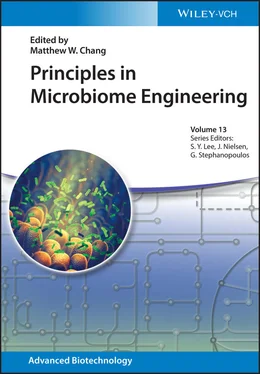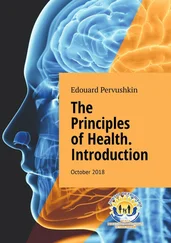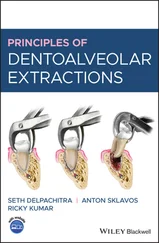Principles in Microbiome Engineering
Здесь есть возможность читать онлайн «Principles in Microbiome Engineering» — ознакомительный отрывок электронной книги совершенно бесплатно, а после прочтения отрывка купить полную версию. В некоторых случаях можно слушать аудио, скачать через торрент в формате fb2 и присутствует краткое содержание. Жанр: unrecognised, на английском языке. Описание произведения, (предисловие) а так же отзывы посетителей доступны на портале библиотеки ЛибКат.
- Название:Principles in Microbiome Engineering
- Автор:
- Жанр:
- Год:неизвестен
- ISBN:нет данных
- Рейтинг книги:5 / 5. Голосов: 1
-
Избранное:Добавить в избранное
- Отзывы:
-
Ваша оценка:
- 100
- 1
- 2
- 3
- 4
- 5
Principles in Microbiome Engineering: краткое содержание, описание и аннотация
Предлагаем к чтению аннотацию, описание, краткое содержание или предисловие (зависит от того, что написал сам автор книги «Principles in Microbiome Engineering»). Если вы не нашли необходимую информацию о книге — напишите в комментариях, мы постараемся отыскать её.
Provides an overview of the techniques and applications insight into the complex composition and interactions of microbiomes Principles in Microbiome Engineering
Principles in Microbiome Engineering
Principles in Microbiome Engineering — читать онлайн ознакомительный отрывок
Ниже представлен текст книги, разбитый по страницам. Система сохранения места последней прочитанной страницы, позволяет с удобством читать онлайн бесплатно книгу «Principles in Microbiome Engineering», без необходимости каждый раз заново искать на чём Вы остановились. Поставьте закладку, и сможете в любой момент перейти на страницу, на которой закончили чтение.
Интервал:
Закладка:
1.4.2 Current Microbiome Project Supporting Infrastructures
The US NIH initiated the research on the human microbiome that triggered a global effort in this field. In 2008, the International Human Microbiome Consortium (IHMC) was established to set up globally accepted policies and coordinate international microbiome initiatives, including those in the EU, US, China, Japan, Singapore, Australia, and Canada. Table 1.5shows the current supporting agencies in different countries.
Table 1.5 Infrastructures supporting microbiome research.
| Countries | Supporting agencies |
|---|---|
| Australia | Commonwealth Scientific, Industrial Research Organisation, National Health and Medical Research Council |
| Canada | Canadian Institutes of Health Research, Genome Canada |
| Europe | European Commission |
| France | Institut National de la Recherche Agronomique |
| Gambia | Medical Research Council |
| Germany | European Molecular Biology Laboratory |
| Ireland | Teagasc Moorepark Food Research Centre, University College Cork |
| Japan | Japan Science & Technology Agency, JST, Ministry of Education, Cultures, Sports, Sciences and Technology, MEXT |
| Kazakhstan | Nazarbayev University |
| Korea | National Research Foundation, Korea Research Institute of Bioscience and Biotechnology (KRIBB) |
| United States of America | National Institutes of Health (NIH) |
| China | Institute of Microbiology, Chinese Academy of Sciences |
1.4.2.1 International and Local Initiatives
The established infrastructures kickstarted various local and global initiatives to accelerate microbiome research. These include databases and research platforms founded by universities, research institutions, and major corporations. These initiatives study diverse research work, focusing on particular human societal niches. Listed below are some of such initiatives.
HMP [286]: The first‐phase HMP (HMP‐1) (2008–2013) is a concerted global effort that investigates samples of donors and studying the microbiome of 15–18 sites of the human body. These microbial taxonomic profiles and metagenomic sequences, described in the form of abundance, lay the foundations for the HMP‐2.
HMP‐2: The second phase of the HMP, also known as the integrated HMP (iHMP), uses the Data Analysis and Coordination Center (DACC) platform to facilitate rapid data retrieval of metagenomic sequence and other data types of the human microbiome and human genetics.
METAgenomics of the Human Intestinal Tract (MetaHIT): MetaHIT (2008–2012) is a European Union initiative that links 15 institutes from 8 countries, providing a multi‐disciplinary and extensive catalogue of microbiome resilience potential in the human body [287]. MetaHIT was succeeded by the Horizon2020 (2014–2020) that advances research in microbiome nutrition and host health.
The Microsetta Initiative (TMI): TMI consolidates the global efforts of profiling the microbiome of collected human samples from across the globe, including educational outreach of microbiome sciences [288]. TMI is the human microbiome research wing of the Earth Microbiome Project.
Million Microbiome of Humans Project (MMHP): Launched at the 14th International Conference on Genomics (ICG‐14) in 2019 [289], the MMHP is global cooperation between scientists from China, Sweden, Denmark, France, Latvia, and other countries studying microbial metagenomics research. This project aims to sequence and profiles the microbiome of one million samples isolated from the human body, to ultimately construct a complete human body microbiome map and build the world's largest human microbiome database using MGI's DNBSEQ™ metagenomic sequencing [290].
Bioinformatic initiatives: The most prominent bioinformatic initiative is the DACC [291] that plays a crucial role in iHMP. The Global Catalogue of Metagenomics (gcMeta) is another bioinformatics platform that archives microbiome data while facilitating data standardization and analysis [55].
Various governments and their affiliated health institutes have initiated many national‐level microbiome projects to encourage microbiome research. In Ireland, the government‐funded Metagenomics of the Elderly programme (ElderMet) investigates the relationship between diet, gut bacteria, and health status in the elderly [292]. The Canadian Institutes of Health Research (CIHR) launched the Canadian Microbiome Initiative (CMI) in 2014 aiming to analyze and characterize the microorganisms that colonize the human body in an effort to harness the microbiome for treatment of chronic disease [293]. In 2017, the second phase of CMI was launched, aiming to develop effective preventative and therapeutic interventions through a deeper understanding of the causational role of the microbiome in human health and disease. The Japanese Human Metagenome was established to study the gut microbiome of healthy Japanese and its microbial diversity, comparing with metagenomic data from HMP [294].
1.4.2.2 Global Foundations
Many multinational companies have jumped into the foray to help push forward microbiome research. These foundations are listed below:
Bill and Melinda Gates foundation has supported 34 institutes/initiatives on the microbiome research, from 2008 to the current day. 1
The Biocodex Microbiota Foundation provides an annual grant of €200,000 for research on the structure of microbiota and the impact of microbiota dysbiosis [295].
The Crohn's & Colitis Foundation has raised over $250 million toward the global IBD research [296].
The W. GARFIELD WESTON foundation has set up the Weston Family Microbiome Initiative providing research grants of up to $200,000 on microbiome translational research to improve the health of Canadians [297].
Wisconsin Alumni Research Foundation (WARF) supports projects on gut microbiome–linked Alzheimer's disease, the impact of day care on a child's microbiome, and the risk of infection with drug‐resistant pathogens [298].
1.5 Concluding Remarks
There is an undeniable link between the microbes that live in the human body with the human host. The microbes and the human host forming the microbiome, establish the individual's health where the microbial composition changes over the age of the host and the biochemical conditions of the host. One of the main determining factors of the host biochemistry is the host diet, where foods can affect how the host cells and the microbiota reacts.
In this chapter, we compare different impacts of diet primarily based on wealth, age, and locality. From a socio‐economic standpoint, wealth influences the eating and lifestyle habits of individuals and in doing so impacts the microbiome. The age influence is mainly due to the differences in consumed nutrients composition affecting the microbiota of infants, children, teenagers, adults, and elderlies. In contrast, the locality provides different types of food, affected by geography, climate, and customs. Thus, we can observe differences in health levels in different countries. It is considered that wealth also influences diet choice and risk of some diseases, mainly because people with different levels of wealth may have different views on the consumption of foods (such as probiotics) and living habits.
Designed diets are currently used to treat or prevent diseases, by controlling the amount of specific dietary components, probiotics, and prebiotics. These treating strategies have been explored in infection, inflammatory diseases, psychological diseases, cancers, metabolic disorders, and other diseases. The changes in the diet affect intestinal epithelial cells and intestinal barrier function as a direct means of interaction with the host. Dietary changes can also influence the microbiota composition, mainly by repressing pathogenic bacterium and promoting the growth of beneficial bacteria. The change in microbiota composition can also influence host immunity. Thus, the diet components that encourage specific species of microbes as means to control disease pathogenesis are currently investigated.
Читать дальшеИнтервал:
Закладка:
Похожие книги на «Principles in Microbiome Engineering»
Представляем Вашему вниманию похожие книги на «Principles in Microbiome Engineering» списком для выбора. Мы отобрали схожую по названию и смыслу литературу в надежде предоставить читателям больше вариантов отыскать новые, интересные, ещё непрочитанные произведения.
Обсуждение, отзывы о книге «Principles in Microbiome Engineering» и просто собственные мнения читателей. Оставьте ваши комментарии, напишите, что Вы думаете о произведении, его смысле или главных героях. Укажите что конкретно понравилось, а что нет, и почему Вы так считаете.












